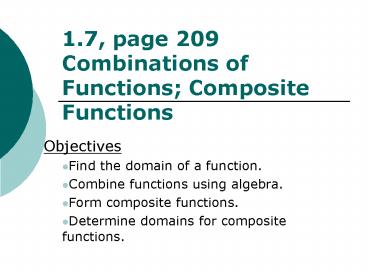1.7, page 209 Combinations of Functions; Composite Functions - PowerPoint PPT Presentation
1 / 17
Title:
1.7, page 209 Combinations of Functions; Composite Functions
Description:
Title: Radical Functions and Rational Exponents Author: MSHS Last modified by: HP Authorized Customer Created Date: 8/10/2004 8:30:57 PM Document presentation format – PowerPoint PPT presentation
Number of Views:114
Avg rating:3.0/5.0
Title: 1.7, page 209 Combinations of Functions; Composite Functions
1
1.7, page 209Combinations of Functions
Composite Functions
- Objectives
- Find the domain of a function.
- Combine functions using algebra.
- Form composite functions.
- Determine domains for composite functions.
2
Using basic algebraic functions, what limitations
are there when working with real numbers?
- A) You canNOT divide by zero.
- Any values that would result in a zero
denominator are NOT allowed, therefore the domain
of the function (possible x values) would be
limited. - B) You canNOT take the square root (or any even
root) of a negative number. - Any values that would result in negatives under
an even radical (such as square roots) result in
a domain restriction.
3
Reminder Domain Restrictions(WRITE IT DOWN!)
- For FRACTIONS
- No zero in denominator!
- For EVEN ROOTS
- No negative under radical!
4
Check Point 1, page 211Find the domain of each
function.
5
The Algebra of Functions, pg 213
6
Finding Domain of f(x) plus, minus, times,
or divided by g(x)
7
See Example 2, page 213.Check Point 2, page 214.
- Let f(x) x 5 and g(x) x2 1. Find
- (f g)(x)
- (f - g)(x)
- (fg)(x)
- (f/g)(x)
8
See Example 3, page 214.Check Point 3
9
Given two functions
f
and
g
, the
composite function
, denoted by
(read as
f
of g of x)
is defined by
10
Composition of FunctionsSee Example 4, page 217.
- Check Point 4
- Given f(x)5x6 and g(x)2x2 x 1,
- find
- a) f(g(x)) b) g(f(x))
11
Domain of
Note Finding the domain of f(g(x)) is
NOT the same as finding f(x) g(x)
The domain of
is the set of
x
all numbers
in the domain of
g
(
g
such that
x
) is in the domain
of
f
.
12
How to find the domain of a composite function
- Find the domain of the function that is being
substituted (Input Function) into the other
function. - Find the domain of the resulting function (Output
Function). - The domain of the composite function is the
intersection of the domains found above.
13
See Example 5, page 218.
- Check Point 5
14
Extra Domain Example
- Find the domain
- There are xs under an even radical AND xs in
the denominator, so we must consider both of
these as possible limitations to our domain.
15
Extra Example Operations with FunctionsGiven
that f(x) x2 - 4 and g(x) x 2, find
- (fg)(x)
- (f-g)(x)
- (fg)(x)
- (f/g)(x)
16
Remember f(x) x2 - 4 and g(x) x 2. Now,
lets find the domain of each answer.
- (fg)(x) x2 x - 2
- (f-g)(x) x2 x - 6
- (fg)(x) x3 2x2 4x - 8
- (f/g)(x) x 2
17
Extra Example Composition
- Given f(x)2x 5 g(x)x2 3x 8, find
- (f?g)(x) and (g?f)(x)
- (f?g)(7) and (g?f)(7)
- What is the domain of these composite functions?































